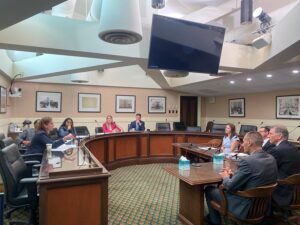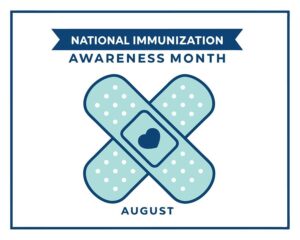Monthly Newsletter
CBF Warns of NIH Cuts Threatening California Life Sciences and Promotes National Immunization Awareness
August 2025
Biotech Select Committee Hears Expert Testimony About NIH Funding Cut Impacts
California’s biotech ecosystem — a global leader in innovation, manufacturing, and medical breakthroughs — is facing mounting threats due to instability in federal policy and funding including $3.8 billion in 2025 National Institutes of Health (NIH) budget cuts with more reductions anticipated in 2026.
At a recent legislative briefing hosted by the Assembly Select Committee on Biotechnology and Medical Technology led by the Committee Chair Assemblymember Chris Ward, academic, life science industry, and nonprofit leaders testified. They warned that federal disruptions—particularly cuts to NIH funding—are already significantly slowing down research pipelines, reducing investment, and weakening the State’s competitive edge.
Panelists emphasized the vulnerability of California’s biotech hubs — San Francisco, San Diego, and Los Angeles — where many small companies depend heavily on federal grants and venture capital, both of which are shrinking. Cuts could affect jobs at all levels, from PhDs to lab technicians. The following is a hearing synopsis:
Dr. Gregory Theyel, Director of the Biomedical Manufacturing Network, emphasized the critical role that both research and manufacturing play in sustaining California’s biomedical ecosystem, which hosts 5,000 of the world’s 15,000 biomed company sites. He noted that small companies are highly vulnerable to federal funding cuts. These disruptions not only threaten cutting-edge work but also risk widespread job losses.
Tim Scott, President and CEO of Biocom California noted that biotech is the second-largest industry in California, with 30% of its life sciences workforce in manufacturing. He said NIH funding is essential, but so is a state-level response. California must act where it can — from protecting R&D tax credits to incentives in keeping companies local.
Mike Guerra, President and CEO of California Life Sciences, underscored the interdependence of the state’s innovation ecosystem, warning that when a link in the research and development chain breaks, the system risks collapse. Guerra also cautioned that proposed legislation to limit mergers and acquisitions could unintentionally harm smaller biotech companies that rely on such partnerships for growth and survival.
Asher Lisec, Vice President of State Policy at PhRMA, emphasized the essential collaboration between academic medicine and biopharmaceutical manufacturers. In 2023 California hosted 2,695 active clinical trials, supported by $3.4 billion in investments. Lisec warned that while the U.S. remains a global leader in pharmaceutical innovation, China is outpacing the U.S. in STEM education and R&D investment.
Dr. Theresa Maldonado of University of California, Office of the President said that the future NIH and NSF cycles are already being scaled back which will disrupt thousands of jobs and limit access to research opportunities — especially for underrepresented students.
Dr. Ruth O’Hara of Stanford University emphasized that academic institutions are essential incubators for biomedical innovation, directly improving patient outcomes and survival rates through proximity to cutting-edge research. She warned that federal funding disruptions could derail this pipeline, with each lost grant at Stanford impacting 5–10 trainees or scientific staff.
Dr. Ikhide Imumorin of CSU Biotech noted that while the CSU system is less research-intensive than UCs or Stanford, it plays a vital role in producing 6,000–7,000 STEM graduates annually. He emphasized that continued federal research support is essential to ensure these graduates have access to the high-paying STEM jobs that drive California’s innovation economy.
Jade Fachin, a graduate student researcher at UCLA stressed that federal grants are earned through rigorous competition, not simply handed out. She shared how funding instability has forced her and her peers to reallocate resources, postpone research activities, and focus only on short-term experiments. Fachin emphasized that these disruptions don’t just affect current graduate students and jeopardize opportunities for aspiring undergraduates.
August is National Immunization Month And More Important than Ever
As students return to classrooms and the fall virus season approaches, National Immunization Awareness Month (NIAM) is a critical time to emphasize the life-saving importance of vaccines — not just in protecting individual health, but in safeguarding public health progress.
Vaccines remain one of the greatest achievements of modern medicine. They protect against dangerous diseases like influenza, tetanus, smallpox, measles, shingles, and polio — many of which were once leading causes of death or lifelong disability. Thanks to decades of vaccine research and innovation, often supported by the National Institutes of Health (NIH), millions of lives have been saved globally according to the World Health Organization.
In 2025, deep federal cuts to NIH funding and vaccine policy rollbacks are disrupting the biomedical research ecosystem that fuels vaccine development. According to vaccine experts across the globe, these cuts threaten clinical trials, new vaccine discoveries, and partnerships between public institutions and the private sector. Even long-standing immunization efforts — such as those targeting childhood diseases and seasonal flu — are at risk of backsliding.
This year, measles outbreaks have surged across multiple states, with cases up more than 2,000% compared to 2023 — a spike that experts say is driven by declining vaccination rates, misinformation, and policy gaps. Federal rollbacks on vaccines coupled with the rise in misinformation have eroded public trust, despite overwhelming scientific evidence supporting vaccine safety and effectiveness.
In response, the American Academy of Pediatrics (AAP) broke from CDC guidance for the first time in nearly two decades, issuing updated recommendations that call for stronger adherence to routine childhood immunizations and continued COVID-19 vaccination for kids and teens.
Life science leaders and frontline providers remain steadfast in advancing vaccine access, education, and evidence-based public health. This August, National Immunization Awareness Month offers a timely opportunity to reinforce the facts and advocate for stronger science-based immunization policy.
Visit these websites to get the latest updates on immunizations: California Department of Public Health, American Association of Immunologists, and the American Academy of Pediatrics.
Stay informed on the latest news and trends on the economic and health benefits of this industry by visiting CABiotech.org
If you have any questions about hosting informational briefings for your colleagues serving in the legislature, contact California Biotechnology Foundation Executive Director Patty Cooper at (916)764-2434 or [email protected].



